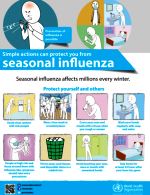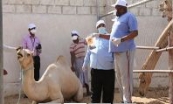Morocco is a low-middle-income country with a population size of 33.01 million (2013)1. Its gross national income (GNI) per capita is US$ 3.030 (2013)1. The Human Development Index rank is 130 out of 186 countries (2013)2.
Virological influenza surveillance was established in Morocco by the National Influenza Centre in 1996. The main objectives of this surveillance were to determine the epidemiologic characteristics of influenza, monitor influenza viruses and determine the concordance between the vaccine and circulating strains. A protocol for influenza surveillance was developed in 1996 and was updated in 2009. Influenza activities were covered financially through the programme of the Centers for Disease Control and Prevention in the United States of America.
Morocco has around 375 health units covering about 12 million people (one-third of the whole population). These units are involved in influenza surveillance. There are 16 regional hospitals, representing the 16 districts in Morocco, involved in severe acute respiratory infection surveillance. They preliminarily detect influenza and other respiratory viruses by immunofluorescence assay using commercial kits. In 2007, one hospital in each region of the country was selected as a sentinel hospital for patients hospitalized with severe acute respiratory infection. In each hospital the data are collected from four units: paediatric, pneumology, medical and intensive care.
The National Institute of Hygiene in Rabat has been recognized as a national influenza centre in Morocco since 2000. Virus isolation, polymerase chain reaction, serology and sequencing are all available and functional at the institute. The National Influenza Centre is functioning well. Influenza vaccine is given to all staff at risk both in the Ministry of Health and in the Ministry of Agriculture and other governmental sectors at risk.
Strengths
The Ministry of Health is in the process of establishing national influenza surveillance, and funding of the laboratory activities will be included and covered by the ministry. An interministerial committee has been established to communicate between all governmental sectors in the country as part of pandemic preparedness. An internet network has been established to link regional hospitals with the National Influenza Centre and Epidemiology Directorate in the Ministry of Health through a website.
Influenza surveillance data are reported in a timely manner from one level to another with no significant delay in reporting. The accuracy and completeness of the reported data are usually checked by phone. The national data from biological and epidemiological surveillance reported in Morocco to date show no circulation of influenza A(H5N1) or any other unusual type, either in birds or humans.
The National Institute of Hygiene has the necessary capacity and potential to be a functioning WHO regional influenza laboratory for the countries of the Eastern Mediterranean Region. The Partnership Contribution fund support will help Morocco to strengthen its epidemiological and virological surveillance capacity for influenza-like illness and severe acute respiratory infection within the routine disease surveillance system.
Gaps and recommendations
The probability of finding different patterns of circulating influenza viruses is high in Morocco because the country attracts a large number of tourists annually, especially during the winter season. According to the Moroccan National Influenza Strategy, several levels of response and precaution will be undertaken in regard to travellers to Morocco from areas of human transmission of influenza, depending on the international situation and the virulence of the circulating virus.
The main limitations of the influenza surveillance system in Morocco are problems related to the continuity of specimen collection due to a shortage of laboratory supplies in some collecting sites and interruptions in internet access. It has been suggested that the Pasteur Institute in Casablanca may participate on a regular basis in the national influenza surveillance and the testing of specimens collected from all the regions in Morocco, not just Casablanca.
It is important to strengthen coordination with the private sector by involving them in the planning and implementation of activities aimed at increasing the coverage of seasonal influenza vaccination. If an effective vaccine against the causative strain were available from the beginning of the pandemic, vaccination of the entire population would have an impact in preventing around 57% of cases, 66% of hospitalizations and 72% of deaths.







